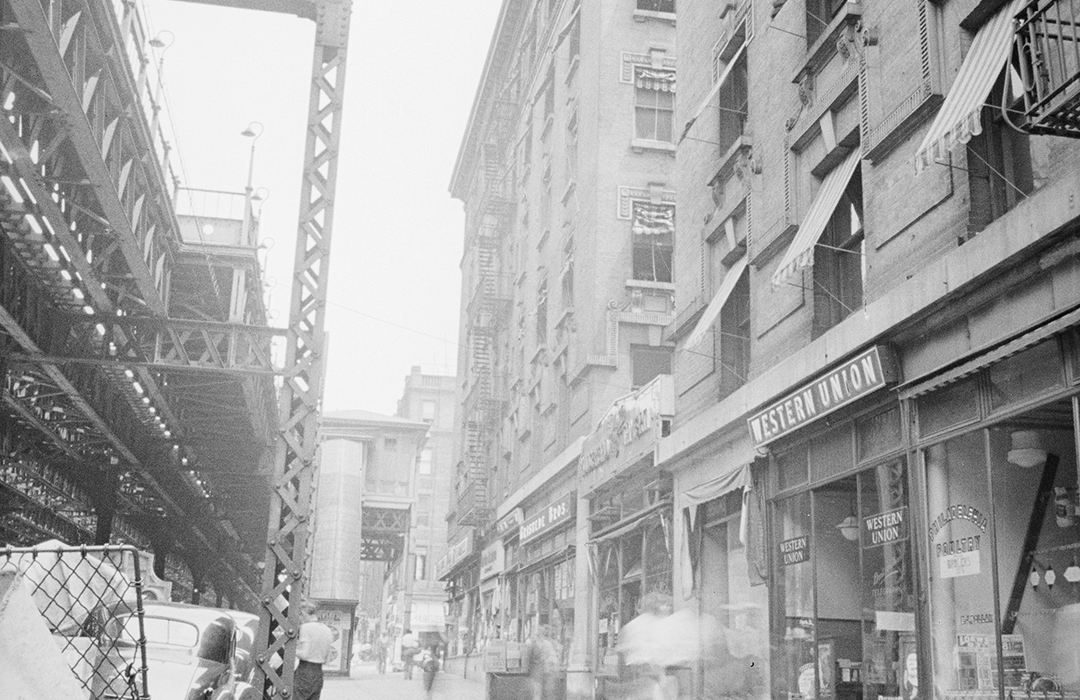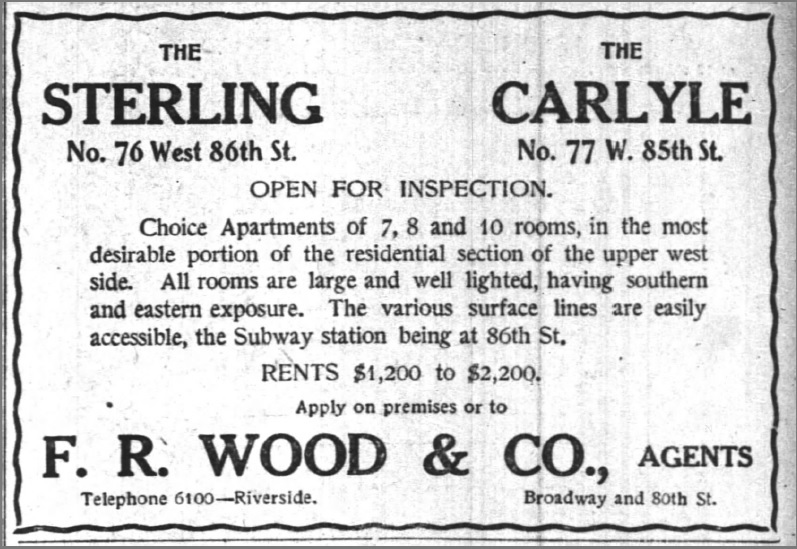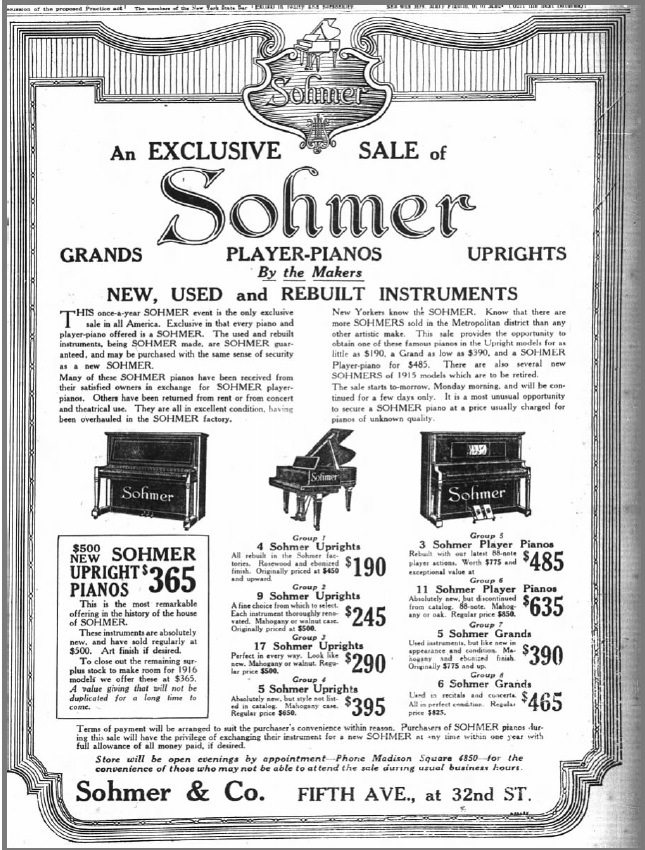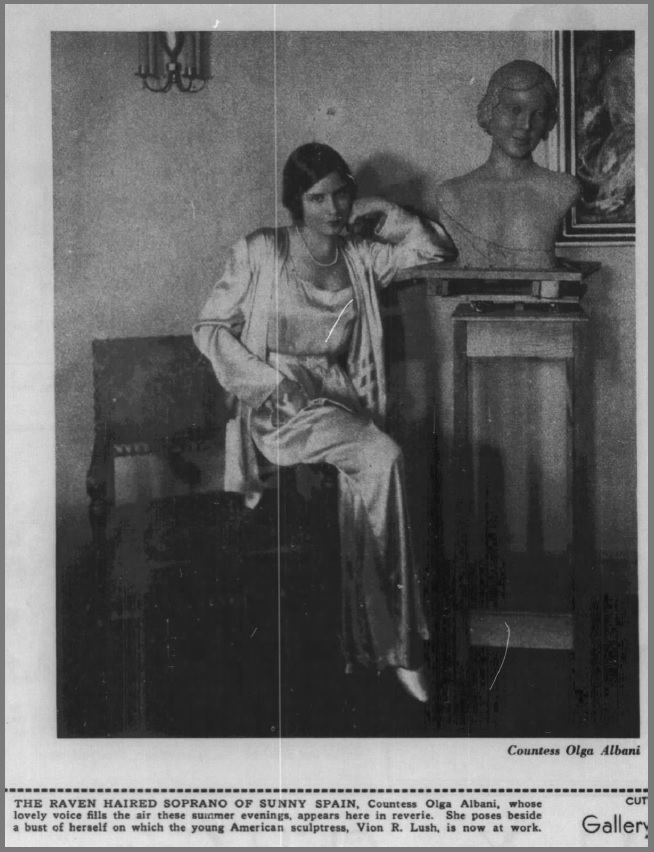The Sterling

The Countess, the Piano King & The Party Box
by Tom Miller, for They Were Here, Landmark West’s Cultural Immigrant Initiative
Ground was broken in 1905 for two mirror-image apartment houses, The Sterling, on the corner of 86th Street and Columbus Avenue, and The Carlyle on the 85th Street corner. Designed by Mulliken & Moeller for developers Harry S. Haupt and Robert S. Finney, the six-story structures were completed the following year—each costing the equivalent of nearly $7.5 million today.
Like its fraternal twin, The Sterling was faced in light brick and limestone and held two commercial spaces on the Columbus Avenue side. Residents upstairs could choose among apartments of 6 to 10 rooms. The new 1906 building boasted the latest in amenities: “electric lights and bells, steam heat, hardwood finish, marble and tile halls, porcelain baths, etc.” Rents ranged from about $2,860 to $5,000 per month in today’s dollars. (The electric bells were to summon servants.) By 1912, it was advertised that “each apartment has telephone connection.”
The Sterling filled quickly with well-heeled residents, like immigrant Josef Kuder who was born in Wolsdorf, Germany. Having learned the art of piano making in Vienna, he came to America in 1854 at the age of 23. He partnered with Hugo Sohmer in 1872 to form the Sohmer & Co. piano firm, one of 171 piano manufacturers in New York City. In a profile of the company published on April 28, 1901 in The Brooklyn Citizen, it was reported that, “between thirty and forty pianos are sold weekly by this firm. When the business first started in ’72 three pianos a week was the extent of the output.”
Hugo Sohmer died on June 8, 1913 at the age of 68. Kuder was so overcome with emotion at the funeral that he had to be helped home. He never recovered from the shock and died in his apartment in The Sterling a month later, on July 24, at age 82.
The Sterling filled quickly with well-heeled residents, like immigrant Josef Kuder who was born in Wolsdorf, Germany. Having learned the art of piano making in Vienna, he came to America in 1854 at the age of 23. He partnered with Hugo Sohmer in 1872 to form the Sohmer & Co. piano firm, one of 171 piano manufacturers in New York City.
At the time the northern shop was home to Adolf de Jong’s “pictures and art goods” store. He would remain in the space into the 1920’s.
Another upper-class immigrant in The Sterling was Countess Olga Hernandez-Albani. Born in Barcelona, Spain, she was the granddaughter of a Spanish admiral and was brought to America in 1908 at the age of 4. She and her husband, Count Anturo Albani of Italy, were living at The Sterling in 1930. Countess Albani did not let her wealth nor her noble title stop her from pursuing a singing career and she starred in radio shows, sang with the Chicago and New York opera houses, and appeared in motion pictures.
Post-Prohibition, the southern store space became the Moosehead Tavern, here by 1934. In 1940 it was purchased by Irish immigrants Jack Phelan, who hailed from Waterford, and Tom McGrath, of Tipperary. The Moosehead remained at least through 1949.
In the 1940’s, there were still some 1,500 fish markets in the New York area; by the 1970’s that number was down to 500. One of these, Powers Fish Market (originally founded in 1889 and still on Columbus Avenue in 1982) landed in the southern storefront. The Party Box catering store arrived soon thereafter next door.
Post-Prohibition, the southern store space became the Moosehead Tavern, here by 1934. In 1940 it was purchased by Irish immigrants Jack Phelan, who hailed from Waterford, and Tom McGrath, of Tipperary.
Today’s visitors will find The Sterling little changed since its opening day in 1906.
Tom Miller is a social historian and blogger at daytoninmanhattan.blogspot.com
LEARN MORE ABOUT
529-539 Columbus Avenue
The Sterling
Keep
Exploring
Be a part of history!
Shop local to support the businesses currently at 529-539 Columbus Avenue:
Meet Avi and Shlomit Tamir!
Meet Karem and Kenyi Sun!






